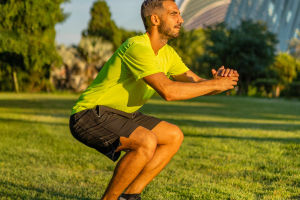Football is a fast-paced game where both speed and endurance play vital roles in a player's success.
Whether we are talking about explosive sprints on the field or maintaining a high level of performance throughout the entire match, improving speed and stamina can make all the difference.
As football players, we need to optimize both our explosive power and cardiovascular endurance to perform at our best. Let's dive into how we can achieve this!
1. The Importance of Speed in Football
In football, speed is essential for almost every aspect of the game. Whether it's chasing the ball, getting into position, or executing a quick counterattack, having a burst of speed can often be the difference between winning or losing a key moment. But speed is not just about running fast in a straight line. It's also about acceleration, agility, and quick direction changes.
Improving speed requires focused training that builds both explosive power and the ability to maintain velocity over short and long distances. We must focus on drills that enhance our quickness, agility, and reaction time.
2. Training to Improve Speed
The first step in improving our speed is to focus on strengthening the muscles used in sprinting. The primary muscles that help us sprint are our quads, hamstrings, glutes, and calves. To work on these areas, we can incorporate specific exercises into our fitness routines, such as:
• Sprint intervals: Short bursts of maximum effort running, followed by rest, train your body to accelerate faster.
• Hill sprints: Running uphill forces our muscles to work harder and improves both speed and power.
• Plyometrics: Jumping exercises like box jumps and squat jumps are great for developing explosive strength in the legs.
Furthermore, speed drills, such as shuttle runs, ladder drills, and cone dribbling, can improve agility and the ability to quickly change direction. A key factor in soccer is the ability to accelerate quickly, and these drills focus on enhancing just that.
3. Developing Endurance for Football
Endurance is another critical component for football players. During a match, we need to be able to keep running for 90 minutes or more, often at a high intensity. This is where cardiovascular training comes into play. To improve our endurance, we should focus on building both aerobic and anaerobic fitness.
Aerobic fitness allows us to sustain activity over long periods, while anaerobic fitness helps us push through short bursts of high-intensity play. A combination of both will ensure that we can maintain energy levels throughout the game.
4. Training to Improve Endurance
To build endurance, we can use the following exercises and strategies:
• Long-distance running: Regular long runs at a moderate pace help build aerobic capacity and improve our stamina over time.
• Interval training: Intervals that mimic the intensity of a match (short bursts of sprinting followed by slow jogging or walking) improve both aerobic and anaerobic fitness.
• Fartlek training: This involves varying our pace throughout a run, incorporating both sprint intervals and slower, steady-paced running. Fartlek training simulates the unpredictability of a real match, helping us build the stamina to perform at different intensities.
Additionally, recovery is an essential part of building endurance. Proper rest and sleep, combined with active recovery exercises like swimming or cycling, help our body repair and strengthen after intense training.
5. Nutrition for Speed and Endurance
Proper nutrition is essential for both speed and endurance. We need to fuel our bodies with the right balance of carbohydrates, proteins, fats, and vitamins to perform at our peak. Carbs provide the energy needed for sprinting and long-distance running, while proteins help in muscle recovery and growth.
Some key nutritional tips for us include:
• Carbohydrates: Eating complex carbohydrates such as whole grains, vegetables, and fruits can provide a steady source of energy.
• Proteins: Lean meats, eggs, and plant-based proteins like beans and lentils are crucial for muscle repair.
• Fats: Healthy fats from sources like avocado, nuts, and olive oil are important for overall health and recovery.
• Hydration: Staying hydrated is vital, as dehydration can negatively affect both speed and endurance.
6. Mental Toughness for Peak Performance
Finally, mental toughness is just as important as physical training when it comes to improving our speed and endurance. Football is a game that requires concentration, determination, and resilience. We must develop the mental strength to push through fatigue and stay focused, especially when the match gets tough.
One way to build mental toughness is by setting goals and tracking progress. Whether it's improving our sprinting time or increasing the distance we can run without getting tired, having measurable goals helps us stay motivated. Visualization techniques, where we picture ourselves achieving our goals, can also boost confidence and focus during training and matches.
Conclusion
Improving speed and endurance as a football player requires dedication to both physical and mental training. By focusing on exercises that enhance acceleration, agility, and stamina, alongside maintaining proper nutrition and mental strength, we can achieve peak performance on the field. Remember, we are constantly working to improve ourselves, and with consistent effort, we can see incredible results. Let's stay focused on our goals and continue striving for excellence!
What strategies or exercises have worked best for you to improve your speed and endurance in football? Share your thoughts in the comments below—we'd love to hear from you!


